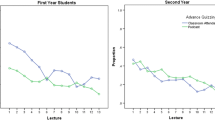Abstract
THIS STUDY evaluated the use of Web-based assessment in the instruction of students enrolled in a Theories of Personality class. During 1999, we compared 297 undergraduates who took online quizzes with 291 undergraduates who took traditional paper-and-pencil quizzes. All online quizzes were generated and maintained by the class instructor using Mallard (an asynchronous Web-based assessment program), which allowed students to choose when, where, and how long to work on their quizzes. Mallard students performed significantly better on achievement criteria (four inclass exams) than non-Mallard students. Survey data indicated that most students reported being “very satisfied” with Mallard. These findings followed similar trends in other forms of computer-assisted instruction. Future research and potential pedagogical applications of Web-based assessment are discussed. Despite the initial time investment required to generate online quizzes with Mallard, student and instructor experiences with the program suggest that it is a promising technology for enhancing instruction in higher education.
Similar content being viewed by others
References
American Psychological Association (2000). PsycINFO database. [Online]. Available: http://ovid1.aiss.uic.edu/ibis/ovidweb
Calibrated Peer Review ™ (2002). [Online]. Available: http://cpr.molsci.ucla.edu/cpr_info/index.asp
Chickering, A.W., & Gamson, Z. (1987). Seven principles for good practice in undergraduate education.AAHE Bulletin, 39, 3–7.
Dempster, F. (1988). The spacing effect: A case study in the failure to apply the results.American Psychologist, 43, 627–634.
Fletcher-Flinn, C.M., & Gravatt, B. (1995). The efficacy of computer assisted instruction (CAI): A meta-analysis.Journal of Educational Computing Research, 12, 219–242.
Flora, S.R., & Logan, R.E. (1996). Using computerized study guides to increase performance on general psychology examinations: An experimental analysis.Psychological Reports, 79, 235–241.
Goldstein, M.D. (1998). Forming and testing implicit personality theories in cyberspace.Teaching of Psychology, 25, 216–220.
Gretes, J.A., & Green, M. (2000). Improving undergraduate learning with computer assisted assessment.Journal of Research on Computing in Education, 33, 46–54.
Kulik, C-L.C., & Kulik, J.A. (1991). Effectiveness of computer-based instruction: An updated analysis.Computers in Human Behavior, 7, 75–94.
Maki, R.H., Maki, W.S., Patterson, M., & Wittaker, D. (2000). Evaluation of Web-based introductory psychology course: I. Learning and satisfaction in online versus lecture courses.Behavior Research Methods, Instruments, & Computers, 32, 230–239.
Mallard [Computer software]. (2000). Champaign, IL: The Board of Trustees of the University of Illinois and Donna Brown.
Mioduser, D., Nachiamias, R., Oren, A., & Lahav, O. (1999). Web-based learning environments (WBLE): Current implementation and evolving trends.Journal of Network and Computer Applications, 22, 233–247.
Sherman, R.C. (1998). Using the World Wide Web to teach everyday applications of social psychology.Teaching of Psychology, 25, 212–216.
Varnhagen, C.K., Drake, S.M., & Finly, G. (1997). Teaching statistics with the Internet.Teaching of Psychology, 24, 275–278.
Wang, A.Y., & Newlin, M.H. (2000). Characteristics of students who enroll and succeed in psychology web-based classes.Journal of Educational Psychology, 92, 137–143.
White, R.J., & Hammer, C.A. (2000). Quiz-o-Matic: A free web-based tool for construction of self-scoring online quizzes.Behavior Research Methods, Instruments, & Computers, 32, 250–253.
Author information
Authors and Affiliations
Corresponding author
Additional information
Preliminary findings were presented at the Teaching Institute of the American Psychological Society, Miami, florida, on June 8, 2000.
ABOUT THE AUTHOR
Eros R. DeSouza received his PhD in Community Psychology from the University of Missouri at Kansas City in 1990. During the summer of 1992, Dr. DeSouza was a fellow at the Center for Advanced Study in the Behavioral Sciences, Stanford University, and in 1999 he became a State Farm Insurance fellow for incorporating technology into instruction. He has been a visiting scholar in Brazil and China. His research interests include cross-cultural issues on education and the workplace, especially the interaction of culture with gender, race/ethnicity, and social economic status. Dr. DeSouza has published many articles and presented numerous papers at regional, national, and international conferences.
Matthew T. Fleming received his MS in Clinical Psychology from Illinois State University in 2001. While at Illinois State University, Mr. Fleming worked as a Graduate Teaching Assistant from August 1998 to May 2000. His research interests include ADHD, aggression, and technology in the delivery of mental health services. Mr. Fleming is presently working as a counselor for the Assertive Community Treatment program at Prairie Center Health Systems, 3545 N. Vermilion, Danville, Illinois 61832.
Rights and permissions
About this article
Cite this article
DeSouza, E., Fleming, M. A comparison of in-class and online quizzes on student exam performance. J. Comput. High. Educ. 14, 121–134 (2003). https://doi.org/10.1007/BF02940941
Issue Date:
DOI: https://doi.org/10.1007/BF02940941



